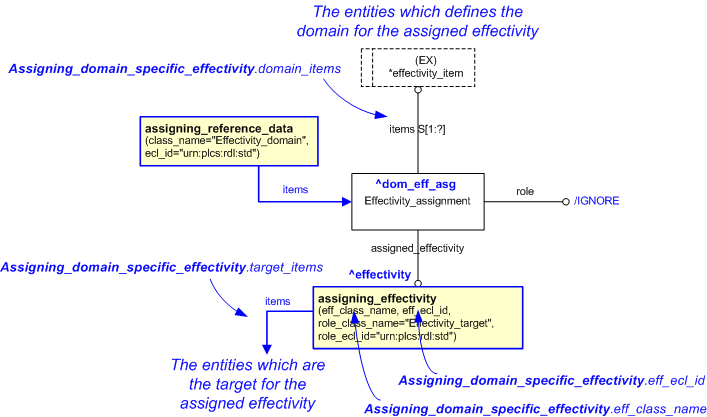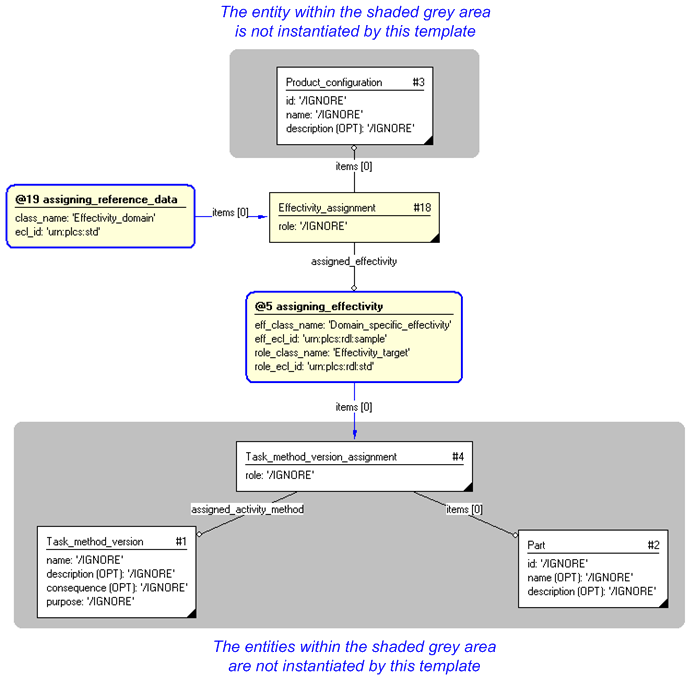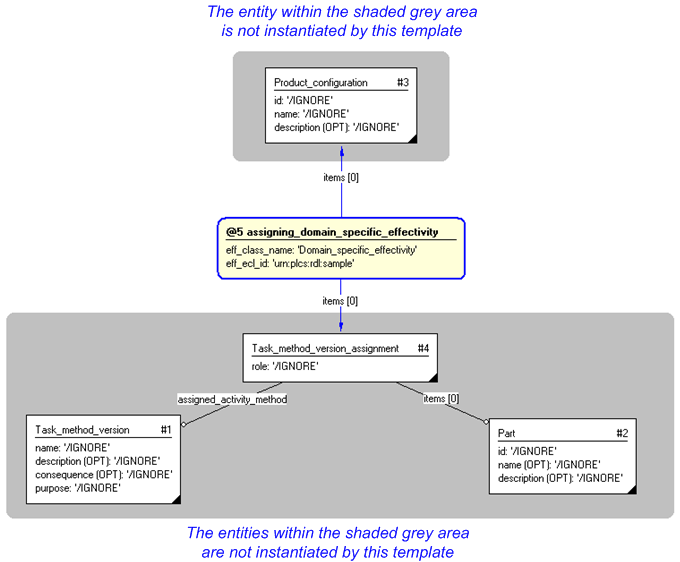Template:— assigning_domain_specific_effectivity (asg_domain_spec_eff)
Capability:assigning_effectivity
![[warning:]](../../../../images/dex/warning.gif) The use of this template is deprecated.
(2008-02-08) The use of this template is deprecated.
(2008-02-08)
|
Date: 2008/05/14 17:05:43
Revision: 1.11
|
![[warning:]](../../../../images/dex/warning.gif) Error T1: There is no template_proxy in the capability assigning_effectivity for the template assigning_domain_specific_effectivity
Error T1: There is no template_proxy in the capability assigning_effectivity for the template assigning_domain_specific_effectivity
Deprecation: Template assigning_domain_specific_effectivity
This section specifies the template assigning_domain_specific_effectivity.
NOTE
The template has been defined in the context of the capability
assigning_effectivity
which provides an overall description of the
relevant parts of the ISO 10303-239 information model and a description
of related templates.
NOTE
An explanation of a template and the associated instantiation path is
provided in the
Template overview
section.
This template describes how to represent effectivity assignments where the effectivity domain is defined as
an instance of a PLCS entity type.
The EXPRESS-G diagram in
Figure
1
shows the templates and EXPRESS entities that are required
to represent the template
"assigning_domain_specific_effectivity".
The text highlighted in blue shows the template parameters.
Figure 1 — An EXPRESS-G representation of the Information model for assigning_domain_specific_effectivity
The graphic for the template to be used in other EXPRESS-G diagrams
is shown in Figure
2
below.
Figure 2 — The graphical representation of the assigning_domain_specific_effectivity template
The following input parameters are defined for this template:
The name of the class being used to classify the
effectivity
(
Effectivity)
This provides the role for the effectivity.
The following classes and their sub-classes can be used:
The identifier of the
External_class_library
storing the definition of the class referenced by the parameter @eff_class_name class.
The items which are the target for the assigned effectivity, i.e. the items
which are subject for restricted usage.
The items which defines the domain in which the @target_items are effective.
The following reference parameters are defined for this template:
Allow the
Effectivity_assignment
entity instantiated in this path to be referenced when this template is used.
%^target = $assigning_domain_specific_effectivity.dom_eff_asg%
The instantiation path shown below specifies the entities that are to be
instantiated by the template.
A description of templates and the syntax for the instantiation path is
provided in the
Templates Help/Information section.
-- Instantiate the Effectivity entity via the assigning_effectivity template /
assigning_effectivity(
items=@target_items,
eff_class_name=@eff_class_name,
eff_ecl_id=@eff_ecl_id,
role_class_name='Effectivity_target',
role_ecl_id='urn:plcs:rdl:std')/
-- Instantiate Effectivity_assignment entity Effectivity_assignment-- Set the Effectivity_assignment attribute role to be ignored Effectivity_assignment.role = '/IGNORE'
-- Bind the Effectivity_assignment to the parameter ^dom_eff_asg. -- The parameter is a reference parameter so the Effectivity_assignment -- entity can be referred to when this template is used. %^dom_eff_asg =
Effectivity_assignment%
-- Assign reference data to Effectivity_assignment /
assigning_reference_data(
items=Effectivity_assignment,
class_name='Effectivity_domain',
ecl_id='urn:plcs:rdl:std')/
-- Bind the Effectivity_assignment to the Effectivity entity -- instantiated by the template assigning_effectivity at the beginning of this path %^assgnd_effectivity = $assigning_effectivity.effectivity%
Effectivity_assignment.assigned_effectivity ->
^assgnd_effectivity
-- Bind the Effectivity_assignment -- to the instances passed into the template through the @domain_items -- input parameter Effectivity_assignment.items ->
@domain_items
The following entities are instantiated with attributes as specified:
The instance diagram in Figure
3
shows an example of the EXPRESS entities and templates that are instantiated by the template:
/assigning_domain_specific_effectivity(eff_class_name='Domain_specific_effectivity', eff_ecl_id='urn:plcs:rdl:sample', target_items='#4', domain_items='#3')/
(an illustration of the consolidated assigning_domain_specific_effectivity template is shown in
Figure
4 below.)
This example illustrates that a Task (Task_method_version #1) assigned to a Part (#2)
is effective in the context of a specific Product_configuration (#3).
Figure 3 — Entities instantiated by assigning_domain_specific_effectivity template
The instance model in STEP ASCII exchange file format (ISO 10303 Part
21 syntax) is:
#1 = TASK_METHOD_VERSION('/IGNORE','/IGNORE','/IGNORE','/IGNORE',$,$);
#2 = PART('/IGNORE','/IGNORE','/IGNORE');
#3 = PRODUCT_CONFIGURATION('/IGNORE','/IGNORE','/IGNORE',$);
#4 = TASK_METHOD_VERSION_ASSIGNMENT(#1,(#2),'/IGNORE');
#6 = EFFECTIVITY('/IGNORE','/IGNORE','/IGNORE');
#8 = CLASSIFICATION_ASSIGNMENT(#10,(#6),'/IGNORE');
#10 = EXTERNAL_CLASS('/NULL','Domain_specific_effectivity','/IGNORE',#11);
#11 = EXTERNAL_CLASS_LIBRARY('urn:plcs:rdl:sample',$);
#12 = EFFECTIVITY_ASSIGNMENT(#6,'/IGNORE',(#4));
#14 = CLASSIFICATION_ASSIGNMENT(#16,(#12),'/IGNORE');
#16 = EXTERNAL_CLASS('/NULL','Effectivity_target','/IGNORE',#17);
#17 = EXTERNAL_CLASS_LIBRARY('urn:plcs:rdl:std',$);
#18 = EFFECTIVITY_ASSIGNMENT(#6,'/IGNORE',(#3));
#20 = CLASSIFICATION_ASSIGNMENT(#22,(#18),'/IGNORE');
#22 = EXTERNAL_CLASS('/NULL','Effectivity_domain','/IGNORE',#17);
The instance diagram in
Figure
4
shows the graphic symbol for the template that is to be
used in other instance diagrams. The example template is:
/assigning_domain_specific_effectivity(eff_class_name='Domain_specific_effectivity', eff_ecl_id='urn:plcs:rdl:sample', target_items='#4', domain_items='#3')/
Figure 4 — Instantiation of assigning_domain_specific_effectivity template
Characterizations
No common characterizations of the template
assigning_domain_specific_effectivity
have been identified. However, the ISO 10303-239 EXPRESS model
may enable other assignments to the entities instantiated by the template.



